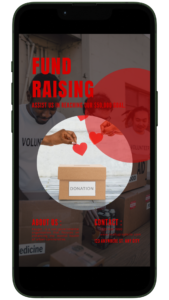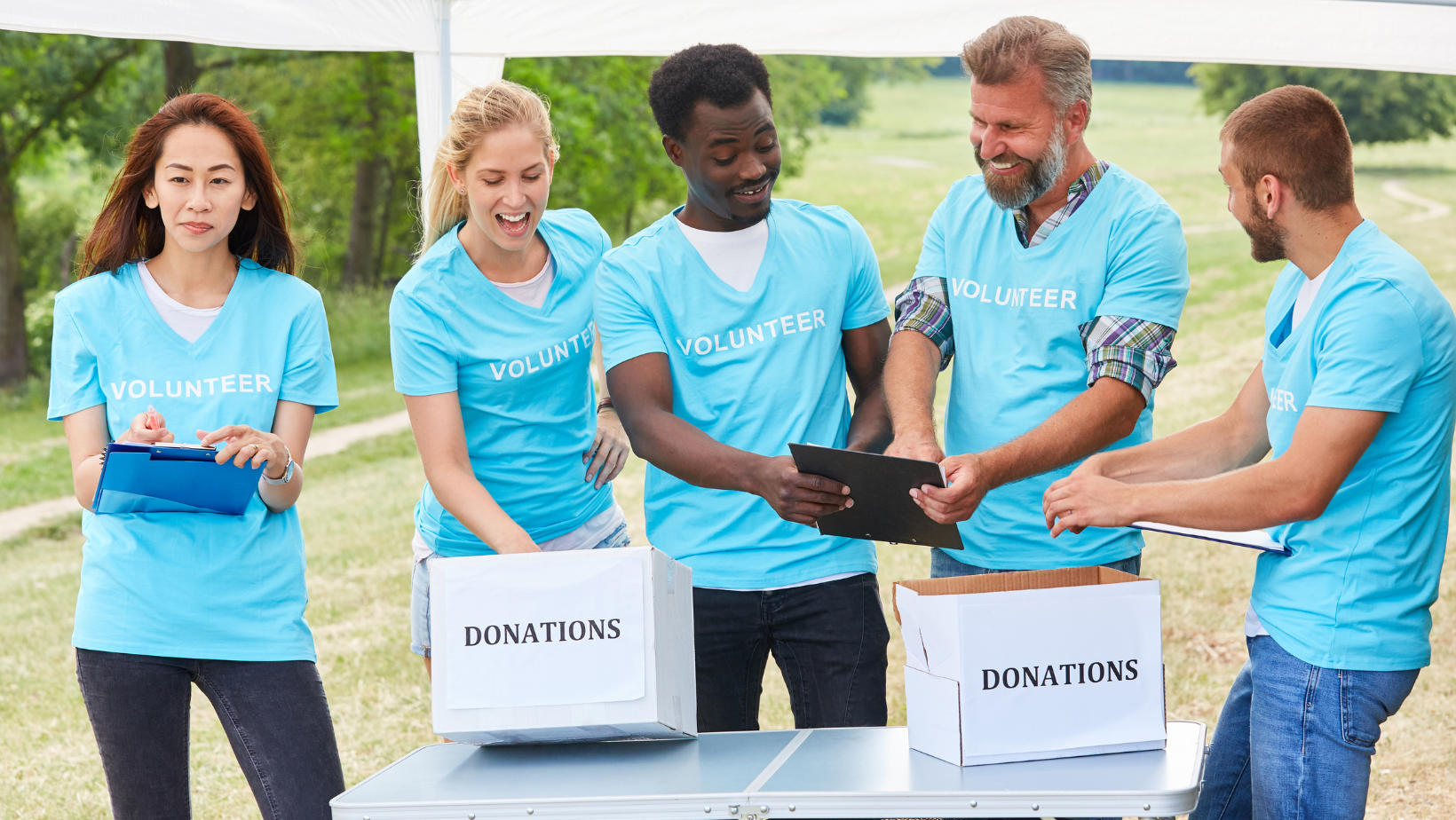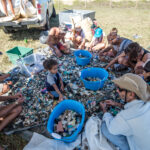Introduction
In the dynamic landscape of today’s world, the realm of event planning, particularly for fundraisers, has undergone a remarkable transformation. The cornerstone of a successful fundraising event is rooted in thorough planning and effective communication, two elements that have become increasingly complex in our fast-paced environment. This complexity is precisely where our cutting-edge digital invitation app, Hobnob, steps in as an indispensable asset.
Fundraisers, whether they are sophisticated gala events, grassroots community gatherings, or online fundraising campaigns, demand a multifaceted approach. Effective fundraising not only involves gathering financial support but also building a strong, engaged community around your cause. This is where Hobnob’s role becomes crucial, offering an all-in-one solution that simplifies and enhances both the planning process and the attendee experience.
The evolution of fundraising strategies, from traditional methods to more modern approaches, necessitates a tool that adapts and scales according to the needs of the fundraiser. Hobnob does just that, serving as a bridge between event organizers, donors, and attendees. Whether you’re steering a high-stakes capital campaign, orchestrating an annual fundraising plan, or igniting a grassroots movement, Hobnob’s suite of features caters to all aspects of event planning and donor engagement.
Moreover, in the context of strategic fundraising planning, Hobnob provides a platform that aligns with your fundraising strategy and goals. Its versatility allows you to target potential donors, engage new supporters, and maintain a connection with your existing donor base, ensuring a higher rate of donor retention. By streamlining the logistics of event planning, from managing RSVPs to sending out instant updates, Hobnob allows you to focus more on the fundraising objectives – be it raising awareness, meeting your fundraising goal, or expanding your supporter network.
In addition, Hobnob’s capabilities extend to enhancing the overall fundraising experience. By integrating social features, such as chat and photo sharing, with the practicality of event management, it fosters a sense of community and belonging among attendees. This not only elevates the experience of the fundraising event itself but also plays a crucial role in building lasting relationships with your supporters.
Understanding the Fundamentals of Fundraising Planning

Setting a Fundraising Goal: The SMART Approach
The inception of every successful fundraising campaign is marked by the establishment of a clear, attainable goal. This pivotal first step is where the SMART goal framework becomes an essential aspect of strategic planning for any fundraiser, be it a grand charity event, a focused capital campaign, or an annual fundraising drive for a nonprofit organization.
Adopting the SMART framework – an acronym that stands for Specific, Measurable, Achievable, Relevant, and Time-bound – is vital in formulating an effective and strategic fundraising plan. Let’s delve deeper into each component of this framework:
Specific: The goal should be well-defined and clear. A specific goal answers the questions of what needs to be accomplished, who will be involved, where it will take place, and why it is important. For instance, instead of setting a vague objective like ‘raise more funds,’ a specific goal would be ‘raise $50,000 for the new community health initiative.’
Measurable: Establish concrete criteria for measuring the progress and success of your fundraising efforts. This could involve setting monetary targets, tracking donor engagement levels, or quantifying the number of new donors acquired. Measurable goals help in maintaining transparency and providing a clear vision of the progress, like aiming to reach a certain percentage of the fundraising target by a specific date.
Achievable: While ambition is important, your goal should also be realistic and attainable. This means considering the resources at your disposal, the scale of your donor base, and previous fundraising successes or challenges. An achievable goal takes into account the practicalities of fundraising capacity and resource availability.
Relevant: Your goal should align with the broader objectives of your organization or the specific cause you are supporting. This ensures that your fundraising campaign resonates with potential donors and aligns with your organization’s overall mission and strategic plan. A relevant goal maintains the focus and drive of both the fundraising team and the supporters.
Time-bound: Setting a deadline for achieving your goal is crucial. A time-bound goal creates a sense of urgency and helps in planning and executing the fundraising strategy more effectively. It enables you to organize your fundraising activities, set a fundraising calendar, and engage with potential and existing donors in a timely manner.
By setting a SMART fundraising goal, you lay a solid foundation for your fundraising campaign. It allows you to develop a strategic fundraising plan that is not only focused and well-organized but also aligned with your organization’s mission and the needs of your target audience. Whether it’s planning a major fundraising event, launching a digital fundraising campaign, or nurturing relationships with individual donors for donor retention, a SMART goal provides a clear and structured path to achieving fundraising success.

Creating a Fundraising Plan Template
Developing a fundraising plan template is akin to charting a detailed map for your fundraising journey. This plan serves as a strategic guide, steering your efforts through every phase of the fundraising process. It’s not just a blueprint for actions but a comprehensive tool that encompasses all facets of fundraising – from the early stages of identifying potential and new donors to the nuanced art of donor stewardship.
Goal Setting: This section is dedicated to defining clear, SMART goals. Your objectives should align with your overall mission and be specific, measurable, achievable, relevant, and time-bound. Goals could range from financial targets to expanding your donor base or enhancing donor retention rates.
Donor Identification and Segmentation: Here, you analyze and segment your potential donor and existing donor base. This involves creating profiles for different donor categories, such as individual donors, corporate sponsors, or foundation grants. Understanding the motivations and giving capacity of each segment helps tailor your approach.
Fundraising Strategies and Methods: This part outlines the various fundraising methods and activities planned, such as online fundraising campaigns, charity events, direct mail, or capital campaigns. It includes strategies for both acquiring new donors and retaining existing ones.
Marketing and Communication Plan: Effective communication is key in fundraising. This section details the marketing and communication strategies, including how you will use digital tools like social media, email newsletters, and your organization’s website to reach and engage your target audience.
Timeline and Fundraising Calendar: An essential component of your plan, this includes a detailed timeline of all fundraising activities, important dates, and milestones. This helps in keeping your campaign on track and ensures timely execution of each element.
Budget and Resource Allocation: Here, you outline the budget for each aspect of your fundraising campaign, including estimated costs and resources needed. This ensures financial efficiency and helps in tracking return on investment.
Monitoring and Evaluation: This section describes the metrics and tools you’ll use to track the progress and effectiveness of your fundraising efforts. It includes data collection methods and regular review intervals to assess performance against goals.
Donor Stewardship and Recognition Plan: A vital aspect of any fundraising plan, this section outlines how you will nurture relationships with your donors, including recognition strategies, donor appreciation events, and communication of impact.
Risk Management and Contingency Planning: Identifying potential risks and having contingency plans in place is crucial. This part addresses possible challenges and outlines strategies to mitigate them.
A well-structured fundraising plan template is indispensable for successful fundraising. It ensures a systematic approach, covering all critical elements from the fundraising goal to donor stewardship. By following this template, your organization can effectively navigate the complexities of fundraising, ensuring a well-organized, targeted, and successful campaign.
Engaging Donors: The Heart of Fundraising
In the nuanced world of nonprofit fundraising, the ability to build and maintain a robust donor base is the cornerstone of success. This task transcends the mere attraction of potential donors; it encapsulates the essential practice of donor retention through strategic and heartfelt donor stewardship. A well-crafted fundraising strategy is pivotal in this regard, integrating personalized engagement tactics, demonstrating the tangible impact of donations, and ensuring continuous communication with supporters.

Personalizing Communication for Stronger Connections
The essence of engaging donors lies in establishing a personal connection. Tailoring communication to reflect the varied interests and motivations of different donor segments is crucial. Personalized emails, heartfelt thank-you letters, and regular updates showcasing how their contributions are making a difference can deepen this bond. It’s about creating a dialogue that resonates with the donor, making them feel valued and an integral part of your mission.
Recognizing and Appreciating Donor Contributions
Recognition and appreciation play a significant role in nurturing donor relationships. This could manifest in numerous forms, from featuring donors in annual reports to acknowledging their support at events or through social media shoutouts. Donor stories, when shared, not only celebrate their contributions but also inspire others. It’s a gesture that goes beyond a simple thank you, creating a sense of partnership and belonging.
Showcasing Impact to Strengthen Trust
Transparency in how donations are utilized is a key factor in retaining donor trust and interest. Regular updates about the projects or initiatives funded by their generosity, supplemented with stories, photos, videos, and testimonials, can vividly illustrate the impact of their support. This transparency not only assures donors of the effectiveness of their contributions but also fosters a deeper understanding and connection with your cause.
Creating Engagement Opportunities
Organizing special events or opportunities for donors to engage with your cause can significantly enhance their connection. Whether it’s an exclusive preview of an upcoming project, a day of volunteering, or an interactive virtual session with your team or beneficiaries, these experiences provide a platform for deeper engagement. It’s about creating moments that allow donors to witness firsthand the change they are helping to bring about.
Valuing Donor Feedback
Encouraging and valuing donor feedback is essential in nurturing a healthy, long-term relationship. Whether through surveys or informal conversations, understanding their experiences and expectations offers invaluable insights. This feedback loop not only aids in refining your strategies but also makes donors feel heard and respected.
Fostering Long-term Relationships through Stewardship
The development of a comprehensive donor stewardship program is crucial in cultivating enduring relationships with your donors. This involves more than just regular updates; it’s about recognizing donor milestones, celebrating anniversaries, and ensuring they are aware of their invaluable role in your organization’s journey.
Leveraging Digital Tools for Enhanced Engagement
In today’s digital era, employing technological tools to augment donor engagement is vital. From utilizing CRM systems for effective donor information management to embracing social media for outreach and interactive platforms for virtual events, technology can significantly elevate the engagement experience.
Understanding and Catering to Different Donor Segments
Recognizing the diversity within your donor base and devising targeted strategies for each segment is imperative. Each group, be it major donors, recurring givers, or one-time contributors, requires a unique approach. Understanding these distinctions enables more effective and meaningful engagement strategies tailored to their specific characteristics.
Leveraging Technology in Fundraising: Introducing Hobnob

In the dynamic world of fundraising, embracing innovative technology is key to success. Hobnob, transcending its role as a mere digital invitation app, stands out as a revolutionary tool in event planning and management. It’s a multifaceted platform that dramatically streamlines the organization and execution of fundraising events, from sophisticated gala events to community-based charity functions.
Streamlining Event Planning and Communication
Hobnob is revolutionizing the domain of fundraising event planning with its array of innovative features, transforming the way organizers approach the logistical complexities of event coordination. Its suite of functionalities, including guest chat, RSVP collection, photo management, and the provision of instant text updates, are pivotal in easing the challenges typically encountered in event management. This digital solution brings a new level of simplicity and efficiency to the planning process, enabling organizers to focus their energy and resources more effectively on the critical aspects of fundraising. These include the development of strategic fundraising plans, fostering engagement with potential and new donors, enhancing donor stewardship, and maximizing opportunities for donation and donor retention.
The platform’s utility extends significantly in the sphere of nonprofit event planning. In scenarios where resources are constrained and the need for streamlined communication is crucial, Hobnob proves to be an invaluable asset. Nonprofit organizations, often operating under tight budgets and limited manpower, find in Hobnob a tool that optimizes their outreach and engagement efforts. Its ability to swiftly circulate information and updates plays a key role in keeping both organizers and attendees in the loop. This feature is particularly beneficial for managing large-scale fundraising initiatives such as capital campaigns, annual fundraising plans, or targeted fundraising activities.
Moreover, Hobnob’s capabilities are instrumental in enhancing the overall experience of event attendees, which is a crucial factor in successful nonprofit fundraising. By ensuring that attendees are well-informed and engaged, the platform aids in building a strong and supportive community around the cause. This aspect of community building is essential not only for the success of the individual event but also for fostering long-term relationships with supporters, which are the backbone of any successful fundraising strategy.
Building and Organizing Groups Effortlessly
Hobnob stands out for its exceptional capability to create and manage groups with remarkable ease, a feature that has become indispensable in the strategic planning and execution of fundraisers and charity events. Its user-friendly interface offers a streamlined method for coordinators to seamlessly connect and communicate with various stakeholders involved in the fundraising process. This includes not just the core organizing team but also extends to volunteers, event attendees, potential donors, and long-term supporters. Such a feature is integral for maintaining alignment across all levels of the event planning and execution process, ensuring that everyone, from the planning committee to individual donors and supporters, is well-informed and engaged.
In the realm of larger-scale fundraising initiatives, such as ambitious capital campaigns, comprehensive annual fundraising plans, or specific fundraising activities, Hobnob’s group management feature becomes even more invaluable. It facilitates effective segmentation and tailored communication strategies, essential for ensuring that messages are precisely targeted and reach the appropriate groups. This level of precision in communication is particularly crucial when dealing with a diverse donor base that includes potential donors, new donors, and long-standing supporters.
Moreover, this feature plays a significant role in donor stewardship and engagement strategies. By enabling organizers to communicate directly and effectively with different donor segments, Hobnob helps in nurturing these crucial relationships. It allows for the sending of personalized updates, invitations to fundraising events, and acknowledgment of their contributions, all of which contribute to a more engaged and committed donor base.
Furthermore, in the context of nonprofit fundraising, where resources are often limited, and the need for efficient organization is high, Hobnob’s group organizing capabilities ensure that volunteer coordination, donor engagement, and event attendee management are handled smoothly and efficiently. This efficiency not only enhances the overall effectiveness of the fundraising campaign but also contributes to the development of a strong, supportive community around the cause.
Enhancing Donor Engagement and Experience
Hobnob is transforming the way organizations interact with donors and event attendees, bringing a new level of interactivity and personalization to the experience. By utilizing the platform’s innovative capabilities to send out creative digital invitations, organizations can add a unique and personalized touch that significantly heightens donor interest and participation in events. This feature is particularly effective in tailoring invitations to match the theme of the fundraising event, whether it’s a sophisticated gala, a community charity event, or an online fundraising campaign, thereby creating a lasting first impression.
The platform’s real-time update feature is another crucial tool in keeping attendees engaged and informed. This aspect of Hobnob is instrumental in fostering a sense of community and involvement among participants. It allows for instant communication of any changes or important announcements, ensuring that all attendees, including potential donors, new donors, and long-term supporters, are kept in the loop. This ongoing engagement is essential not only for the smooth running of the event but also for enhancing the overall attendee experience.
Furthermore, Hobnob’s functionality in managing a fundraising calendar is a game-changer for organizers. This feature simplifies the complex task of keeping track of various fundraising activities, strategic fundraising plans, and other fundraising initiatives. For organizers juggling multiple tasks, from donor stewardship to event planning, having a centralized and easily accessible calendar ensures that every aspect of the fundraising event is meticulously planned and executed. It’s a tool that aids in maintaining a high level of organization, which is vital for the successful outcome of any fundraising event.
The seamless organization facilitated by Hobnob also plays a significant role in strengthening the relationship between the organization and its donor base. By ensuring a well-organized and engaging event, organizations can foster stronger connections with their donors. This enhanced engagement leads to better donor retention, as supporters are more likely to continue their involvement with a cause when they have positive and memorable experiences.
Advanced Fundraising Methods and Tactics
Online Fundraising and Digital Tools
In the evolving landscape of fundraising, the integration of online tools has become integral to the success of any fundraising strategy. Digital solutions, including platforms for communication, event management, and donor engagement, are redefining how nonprofit organizations connect with their audience and execute fundraising plans.
Among these digital tools, platforms like Hobnob offer specific functionalities such as guest communication, RSVP collection, and photo sharing. These features are useful in streamlining certain aspects of event management, particularly in organizing groups and maintaining engagement with event participants. However, the scope of digital tools in fundraising extends far beyond these functionalities.
Google Ad Grant, for example, is a powerful tool for amplifying an organization’s online presence. It helps in reaching a wider and more diverse audience, crucial for expanding the donor base and increasing the visibility of fundraising campaigns. This approach is particularly effective in capital campaign and strategic fundraising initiatives, where broadening the reach can significantly impact the campaign’s success.
Further, the use of online donation form, digital fundraising platforms, and social media channels has transformed the way donations are collected and managed. These tools not only facilitate easy and secure transactions for donors but also provide organizations with valuable data for donor stewardship and engagement strategies.
Moreover, the integration of digital tools into fundraising efforts enables organizations to effectively segment their audience, delivering targeted messages to potential donors, new donors, and long-term supporters. This tailored communication is crucial in building meaningful relationships with different donor segments and ensuring the success of fundraising activities.
Effective online fundraising also involves strategic planning and execution. Digital tools assist in creating detailed fundraising calendars, managing fundraising events, and tracking the progress of fundraising activities. This level of organization and precision is key to the successful implementation of a nonprofit fundraising plan.
Utilizing Data and Analytics
In today’s dynamic fundraising landscape, truly understanding your donor base and the effectiveness of your fundraising tactics has become more crucial than ever. This is where the power of data analytics comes into play, offering a window into the preferences and behaviors of your donors. It’s like having a roadmap that guides you in refining your fundraising strategy, allowing for a more personalized approach in your communications and maximizing the impact of your efforts.
When we delve into data analytics, it’s not just about numbers and charts; it’s about uncovering stories and insights that can transform the way we connect with our supporters. Whether we are developing an annual fundraising plan, orchestrating a capital campaign, or planning various fundraising events, data analytics helps us identify what resonates best with our audience. It’s about finding out which strategies work and which ones need tweaking, ensuring that we are always on the right track.
This approach allows us to segment our donor base effectively, identifying potential donors, engaging new donors, and nurturing long-term supporters with tailored messages. Imagine being able to craft communication that speaks directly to the interests and motivations of each group – that’s the kind of precision data analytics brings to the table.
Moreover, incorporating data analytics into our nonprofit fundraising plan is like giving ourselves a crystal ball. It helps us predict trends, adapt our strategies, and make informed decisions. This could mean optimizing our online fundraising campaigns, fine-tuning our donor stewardship programs, or adjusting our fundraising calendar to better align with when our donors are most likely to engage and contribute.
Data analytics also shines a light on the path to more successful fundraising events. By looking back at data from past events, we get a clearer picture of what worked and what didn’t, allowing us to craft events that are not just enjoyable but also incredibly effective in achieving our fundraising goals.
And let’s not forget about the financial side of things. Data analytics aids in smarter budgeting and resource allocation. It’s like having a financial advisor right at our fingertips, showing us where to invest our efforts for the best return on investment.
Innovative Fundraising Ideas and Activities
When it comes to fundraising, creativity and innovation are key to capturing the interest of supporters and potential donors. The spectrum of fundraising activities is vast and varied, ranging from time-honored charity events to more unconventional and imaginative fundraising efforts. A well-crafted strategic fundraising plan should ideally blend a variety of fundraising methods and initiatives, designed to align with the diverse interests and preferences of individual donors.
Exploring innovative fundraising ideas involves thinking beyond the traditional. For instance, a nonprofit organization might consider hosting a virtual fundraiser, utilizing platforms like Google Ad Grants to boost online presence and reach a wider target audience. This digital approach not only broadens the reach but also offers new opportunities for engagement.
In planning these activities, it’s crucial to incorporate a mix of fundraising efforts that resonate with different segments of your supporter base. This could range from large-scale capital campaigns aimed at securing major gifts to smaller, community-based fundraising events that focus on building and nurturing relationships with new donors and long-term supporters.
Effective fundraising planning also involves meticulous donor stewardship. It’s about ensuring that every fundraiser, whether it’s an elegant gala or an online fundraising challenge, provides an opportunity for meaningful engagement with donors. This could be through personalized communication, recognition in a foundation directory, or involvement in the planning process itself.
Additionally, nonprofit event planning is a critical component of a successful fundraising strategy. This involves everything from selecting the right venue and date to ensuring that donation forms are easily accessible and that event attendees have a memorable experience. The goal is not just to raise funds but to create an event that leaves a lasting impression, thereby fostering a sense of community and commitment to the cause.
When it comes to the actual execution of these events, having a robust fundraising plan template is invaluable. It serves as a roadmap, guiding the organization through each step of the fundraising process, from initial concept to post-event follow-up. This template should outline the various fundraising methods and tactics to be employed, tailored to the target audience and the specific goals of the fundraising initiative.
Conclusion: The Path to a Successful Fundraising Event
Planning for fundraisers is a multifaceted process that requires strategic planning, effective communication, and the right tools. By integrating a digital solution like Hobnob, the complexities of fundraising event planning are significantly reduced, allowing you to focus on the core objective – raising funds and making a difference. Remember, a well-executed fundraising effort not only achieves its financial goal but also strengthens the connection between your organization and its supporters, paving the way for future success.
In addition, the implementation of a nonprofit fundraising plan is crucial for nonprofit organizations, ensuring that their fundraising efforts are aligned with their mission and values. This involves creating a strategic fundraising plan that not only focuses on meeting immediate financial goals but also on building a sustainable donor base and foundation directory for long-term success.
A successful fundraising event is one that not only achieves its fundraising goal but also enhances the overall donor experience. This includes ensuring a seamless event experience for attendees, from the moment they receive the digital invitation to the post-event follow-up. Utilizing tools like Hobnob for fundraising event planning can significantly enhance this experience, facilitating effortless communication with event attendees and efficient management of the fundraising calendar.
Ultimately, the success of a fundraising effort is measured not just in the funds raised, but also in the strength of the connection forged between the organization and its supporters. A well-executed event strengthens this bond, paving the way for future collaborations and ongoing support. Through thoughtful planning, strategic execution, and the effective use of digital tools and fundraising tactics, organizations can host successful fundraising events that resonate with their donors and leave a lasting impact on their cause.






















